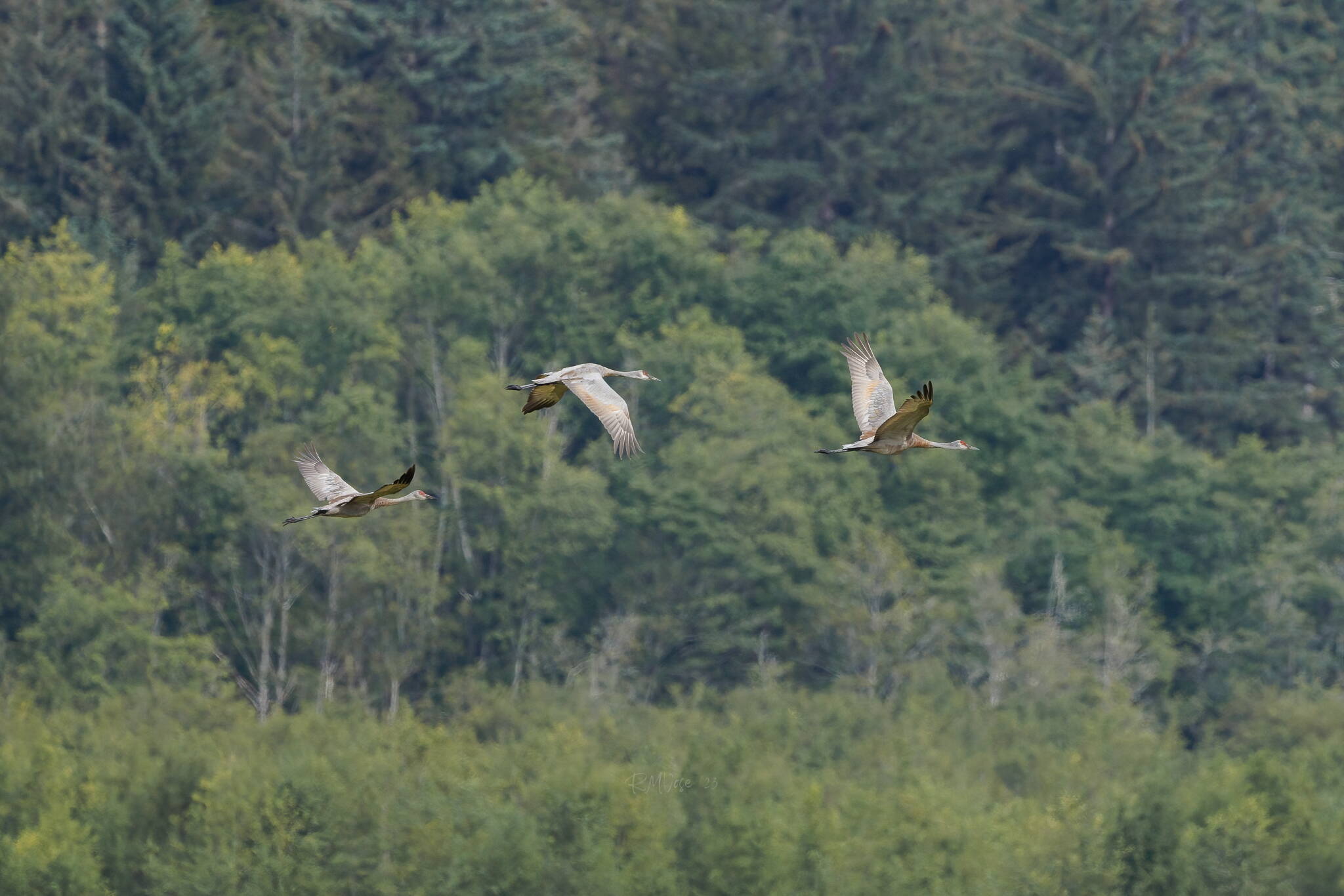One sunny day near the end of August, a friend and I walked on the wetlands on the west side of the river. Not many birds and most of the flowers had finished blooming. So we rambled along, chatting quietly. Suddenly, we both perked up, grinned, and said “Cranes!!!” We’d heard the wonderful, carrying call of sandhill cranes, never to be confused with anything else and always thrilling.
I looked with binoculars over toward the western edge of the wetlands, near the Mendenhall Peninsula, and saw one crane head poking up out of the tall grasses. We noticed a photographer moving slowly and cautiously toward the source of the calls, making good use of cover provided by a huge, rooty snag. Nothing seemed to happen for several minutes — the now-motionless photographer was well-screened behind the snag and no crane heads could be seen.
Then three cranes leaped out of the grass and took flight, initially headed north and then veering off in another direction. In case we needed it, there was the visual confirmation that indeed cranes were there. Another one was reported from Twin Lakes, two days later. I later learned that two cranes were seen in this vicinity in early July; one was injured, with a gimpy leg, but that improved and both birds flew off in mid-August.
I’d heard rumors that migrating sandhills sometimes show up in Juneau. They are not common here, and somehow that made our sighting (and hearing) even more satisfactory. However, they are often seen in Gustavus.
These cranes are roughly three feet tall with wingspan of about six feet, considerably smaller than the endangered whooping crane. But there is substantial geographic variation in body size and proportions. The Arctic and Alaskan breeders tend to be a bit smaller than the rest, with relatively shorter bills and legs, and relatively longer wings.
These cranes are omnivores — they eat all kinds of stuff: tubers and bulbs, berries, seeds, insects, snails, crayfish, small vertebrates such as snakes, frogs, and mice, nestling birds and eggs — the variety depending on location and season (and probably individual preferences). Although they certainly grab lots of food from the ground surface, much of their food is grubbed up from soft soil. During migration, harvested grain fields offer popular foraging places where the birds collect fallen seeds.
Sandhill cranes have nesting grounds all over much of northern North America and even in far eastern Siberia. There are localized resident populations in Florida, Mississippi, and Cuba, but most populations are migratory. The breeding range is reduced from what it once was, because of increased agricultural uses and resulting habitat loss.
According to the Alaska Department of Fish and Game, Alaska has two distinct breeding populations. One nests in western, northern and interior Alaska and, along with those that nest in Siberia, migrates east and south to Texas, southwestern U.S., and Mexico. The other nests near Bristol Bay, on the Alaska Peninsula, near Cook Inlet and in Southeast; these migrate along the Pacific Coast and winter in California’s Central Valley. There are nesting records for Southeast, but I don’t know about the Juneau area specifically.
Sandhills usually prefer to nest in wetlands such as bogs and fens, shallow marshes, wet tundra, and damp grasslands, but sometimes they nest on dry ground. Nests built in watery habitats are little islands of piled-up vegetation with a nest cup on top, but terrestrial nests are said to be just shallow scrapes with a few grasses and feathers.
The usual clutch size is one or two eggs; larger clutches are rare. In clutches of two or more, the eggs are laid at two-day intervals. Incubation takes about 30 days and begins with the first egg laid, so the eggs do not hatch on the same day. Sometimes the second egg is just abandoned after the first hatches. Both parents develop brood patches and incubate during the day, but females usually do most of that work during the night.
Incubating parents talk to their chicks before they hatch, and the chicks also talk to their parents. After hatching, the chicks are soon able to move around well and generally leave the nest after a day or so. They follow their parents around as they forage. Chicks in northern populations (but not in the southernmost ones) can regulate their body temperature when they hatch. Chicks can be brooded under their parents’ wings or on their backs for a few weeks.
If there are two chicks, sibling aggression between the chicks is common, and parents often separate the brood, each adult tending one chick. Very young chicks are fed bits of food directly, bill to bill, but later the adults just drop food in front of a young one. The chicks grow quickly, their legs and wings reaching nearly adult size in a couple of months; full adult weight takes a bit longer. Family members stay together all summer and fall and through the winter. During and after the next northward spring migration, parents and juveniles separate, the adults to begin the next nesting cycle and the juveniles to join up with age-mates in flocks.
Some sandhills are sexually mature and ready to form pair bonds when they are three years old, but this is unusual; full maturity and formation of the first pair bonds often doesn’t happen until the cranes are five or six years old. Once a pair bond forms, the pair is socially monogamous, although extra-pair copulations occur. Pairs commonly stay together, year to year, unless a nesting attempt fails — then pairs often break up and new mates are chosen.
Because sandhills are slow to reach sexual maturity and have small broods of young, depleted populations cannot restore themselves quickly. Therefore over-hunting or weather catastrophes could have lasting negative effects on a population.
• Mary F. Willson is a retired professor of ecology. “On The Trails” appears every Wednesday in the Juneau Empire.

